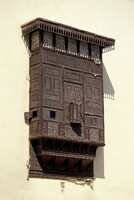Cairo: Mashrabiya Windows
unknown (Egyptian (modern))

Download1A2-EG-C-CMW-B1_cp.jpg (582.3Kb)
Date
1900-2000Description
Mashrabiya screen over a window in Coptic Cairo, side view; Wood continued to be scarce and expensive in the Islamic lands around the Mediterranean, and virtually all the woodwork produced in the area after ca. 1250, from furniture to ceilings, is based on the assemblage of small pieces. Lattice-like screens of turned wood (Arabic; mashrabiyya or al-shimasa; Spanish; ajimeces) became widespread. Lattices or screens of perforated stone in Islamic architecture are called jali. Source: Grove Art Online; http://www.groveart.com/ (accessed 1/18/2008)
Type of Work
meshrebeeyehSubject
architectural exteriors, decorative arts, architectural elements, Twentieth century
Rights
Rights Statement
Licensed for educational and research use by the MIT community only